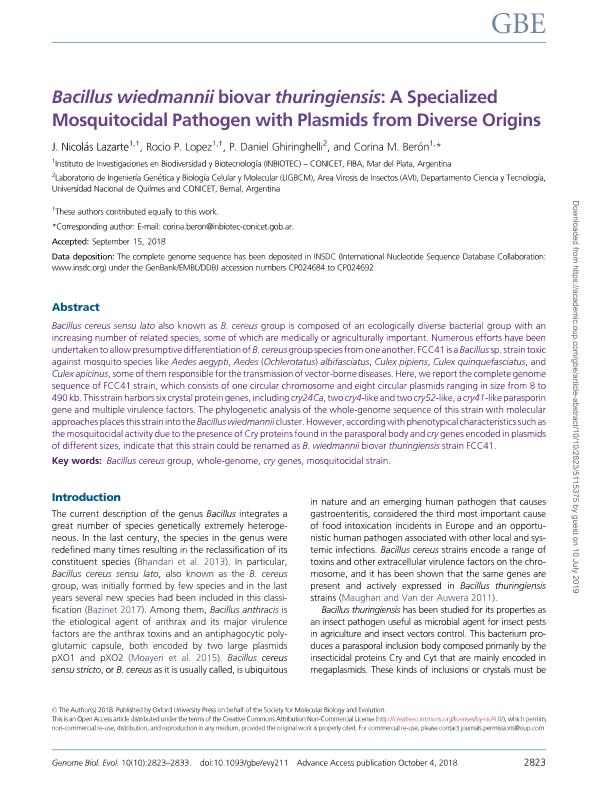Artículo
Bacillus Wiedmannii biovar thuringiensis: A specialized mosquitocidal pathogen with plasmids from diverse origins
Fecha de publicación:
10/2018
Editorial:
Oxford University Press
Revista:
Genome Biology and Evolution
ISSN:
1759-6653
Idioma:
Inglés
Tipo de recurso:
Artículo publicado
Clasificación temática:
Resumen
Bacillus cereus sensu lato also known as B. Cereus group is composed of an ecologically diverse bacterial group with an increasing number of related species, some of which are medically or agriculturally important. Numerous efforts have been undertaken to allowpresumptive differentiation of B. Cereus group species from one another. FCC41 is a Bacillus sp. Strain toxic against mosquito species like Aedes aegypti, Aedes (Ochlerotatus) albifasciatus, Culex pipiens, Culex quinquefasciatus, and Culex apicinus, some of them responsible for the transmission of vector-borne diseases. Here, we report the complete genome sequence of FCC41 strain, which consists of one circular chromosome and eight circular plasmids ranging in size from 8 to 490 kb. This strain harbors six crystal protein genes, including cry24Ca, twocry4-like and two cry52-like, a cry41-like parasporin gene and multiple virulence factors. The phylogenetic analysis of the whole-genome sequence of this strain with molecular approaches places this strain into the Bacillus wiedmannii cluster. However, according with phenotypical characteristics such as the mosquitocidal activity due to the presence of Cry proteins found in the parasporal body and cry genes encoded in plasmids of different sizes, indicate that this strain could be renamed as B. Wiedmannii biovar thuringiensis strain FCC41.
Palabras clave:
BACILLUS CEREUS GROUP
,
CRY GENES
,
MOSQUITOCIDAL STRAIN.
,
WHOLE-GENOME
Archivos asociados
Licencia
Identificadores
Colecciones
Articulos(INBIOTEC)
Articulos de INSTITUTO DE INV. EN BIODIVERSIDAD Y BIOTECNOLOGIA
Articulos de INSTITUTO DE INV. EN BIODIVERSIDAD Y BIOTECNOLOGIA
Citación
Lazarte, Jorge Nicolás; Lopez, Rocio de la Paz; Ghiringhelli, Pablo Daniel; Berón, Corina Marta; Bacillus Wiedmannii biovar thuringiensis: A specialized mosquitocidal pathogen with plasmids from diverse origins; Oxford University Press; Genome Biology and Evolution; 10; 10; 10-2018; 2823-2833
Compartir
Altmétricas




